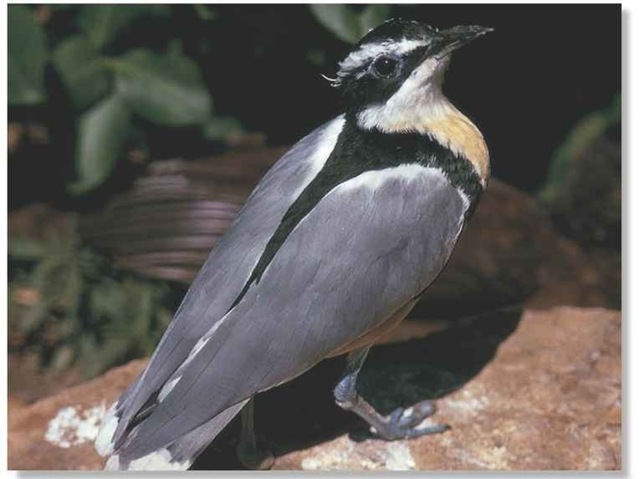ORDER
Charadriiform.es
FAMILY
Glareolidae
GENUS & SPECIES
KEY FEATURES
• Terrestrial bird; uses sand to incubate its eggs, which are laid on an exposed patch of riverbed
• Exceptionally fearless, and reputedly plucks food from the gaping mouths of crocodiles
• A fast and nimble runner, it captures insects or stalks them with heronlike deliberation
WHERE IN THE WORLD !
Distributed across sub-Saharan Africa, from Senegal to Ethiopia; found mostly north of the equator, but extends to Angola in the southern tropics; populations in Egypt have become extinct

Lifecycle
A spirited bird that adds a splash of color to villages and farmland, the Egyptian plover also fascinates with its clever use of sun, sand and water when rearing its young.
HABITAT
The plover inhabits the edges of several of the great rivers of Africa, including the Nile, Congo and Niger. But its habitat needs mean that it is found only on certain stretches.
The plover favors sandbars, which break the surface where rivers run wide and shallow. It also favors slow-flowing waters moving through lowland scrub or lightly wooded savannah.
After the breeding season, when many sandbars disappear under floodwater, the plover may be found in a broader range of wetland sites, including the gravel shores of freshwater lakes. It dislikes densely forested riverbanks, and is rarely seen on saltwater estuaries. The plover often frequents riverside villages, from which it may venture into nearby cultivated fields.
Sidelined The Egyptian plover prefers sandy riverbanks.
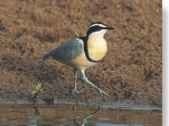
BEHAVIOR
The Egyptian plover is one of the tamest of birds, living happily alongside villagers and behaving with indifference toward fishermen.
Whether its fearlessness lives up to its alternative name of crocodile-bird is open to debate. As long ago as the fifth century BC, the Greek historian Herodotus spoke of a small bird entering the open jaws of basking crocodiles to remove leeches from their mouths. Reports of this behavior have persisted ever since. As yet, there remains no proof of it, although the plover is remarkably bold in the presence of crocodiles and may run across their backs.
This brave bird is equally undaunted by birds of prey. It chases and even attacks black kites, which are more than three times its size. Its pugnacious nature extends to its own species during the breeding season, but at other times of the year the plover is more social, forming flocks of up to 60.
Feather duster Preening is essential in the plover’s sandy home.
BREEDING
No other bird has breeding habits quite like those of the Egyptian plover. It nests during the dry season, when river levels are low enough to expose banks of sand in midstream. On its chosen sandbar, it scrapes out a hollow in which to lay its eggs.
At night, the clutch is incubated with body heat by one of the parents, but shortly after dawn the sitting bird rises, covers the eggs with sand, and leaves them unattended. By mid-morning, with the sun threatening to overheat the nest, the parents cool the sand with water ferried in their belly plumage, and continue to dampen the nest until late afternoon.
The chicks can run an hour after hatching. When a predator approaches, they nestle down and stay still while their parents cover them with sand. Parents protect the chicks for 3-4
KEEPING COOL
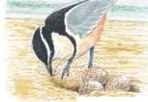
1 Blanketing…
An Egyptian plover lets the sun incubate its speckled eggs by flicking warm sand over them.
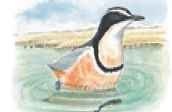
2 Wading…
In the midday heat, the plover keeps the clutch from dehydrating by first soaking its belly feathers.
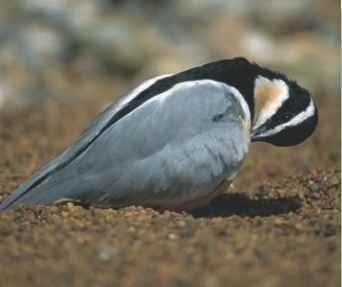
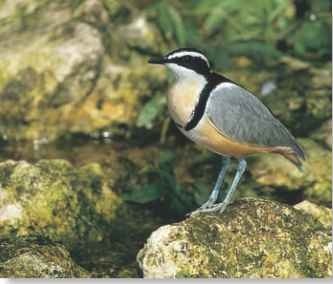
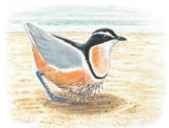
3 Shower time…
The plover lets water from its plumage seep into the sand so the eggs can be cooled off.
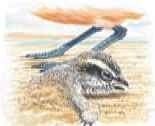
4 Break through
A newborn chick struggles out of the sand, taking its first drink from its parents’ wet feathers.
# Outside the breeding season, the Egyptian plover may join flocks of the spur-winged lapwing, Vanellus spinosus, a member of the plover family.
The juvenile Egyptian plover resembles its parents in plumage pattern, but has a less distinct breast band, and reddish flecks on its head, neck, rump and wings.
CONSERVATION
Although in the 20th century it became extinct in Egypt, the Egyptian plover remains common in most of its current range. Its preference for rivers makes it less vulnerable i’io wetland drainage than marsh-dwelling wading birds, but high water levels as a result of dam-building projects are a threat.
FOOD & FEEDING
With its quick-stepping gait, the Egyptian plover resembles a wind-up toy as it races across the ground in pursuit of insects. Short sprints are punctuated by halts and sudden changes of direction.
Spiders, beetles and other scurrying invertebrates are captured in this way, and some flying insects are also caught after a chase.The bird also creeps up on flies resting on the ground until they are within striking distance of its bill.
Most hunting takes place on exposed sand or gravel, either in rivers or along their banks.The plover also forages by wading into shallow water and pulling out any prey that it can reach without submerging its head.
The Egyptian plover unearths worms, mollusks, subterranean insects and their larvae by probing with its bill in damp sand or by digging into the surface with both feet. It can even lift pieces of driftwood and overturn stones of almost its own weight.
The plover drinks from streams and lakes. Occasionally, it seeks food away from water; moving to open ground.
Snap shot The plover feeds on the ground, stopping and pecking at insects with a sudden jab of its bill.
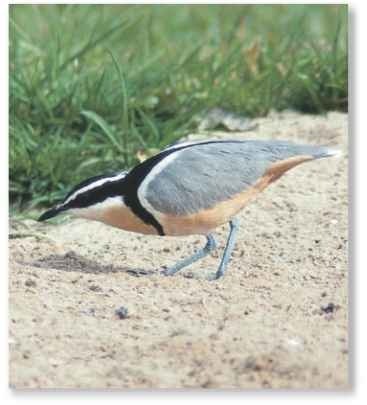
Profile
Egyptian Plover
Slightly hunched in appearance on the ground, the Egyptian plover reveals its stunning plumage and pointed wings in flight.
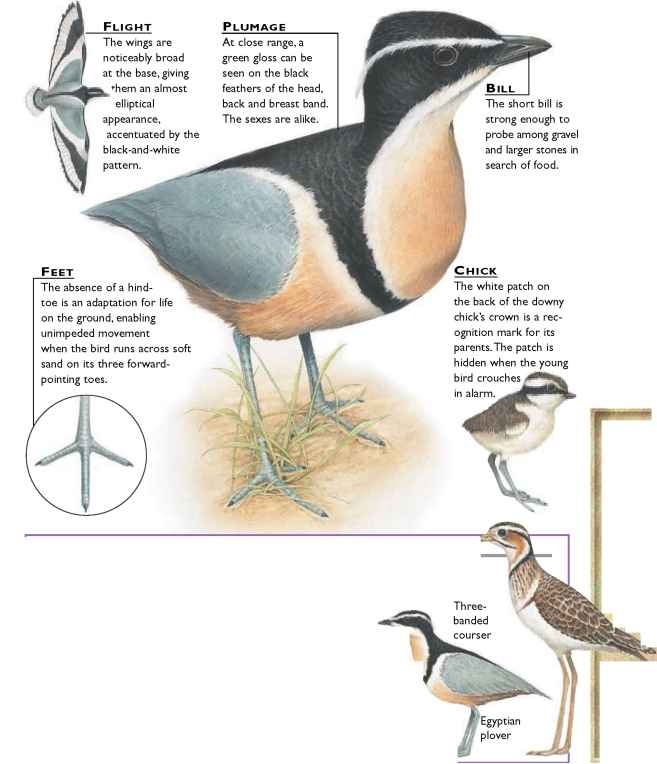
The short bill is strong enough to probe among gravel and larger stones in search of food.
The white patch on the back of the downy chick’s crown is a recognition mark for its parents. The patch is hidden when the young bird crouches in alarm.
CREATURE COMPARISONS -
Whereas the Egyptian plover is associated with inland waters, its relative the three-banded courser (Rhinoptilus cinctus) is found in the scrub, bushland and woodland of East Africa. Largely active from dusk till dawn, the courser uses its mottled brown upperparts to disguise itself when roosting under a bush during the day.The courser has three bands on its neck and breast:At the top, there is a chestnut band, then a thicker band of mottled brown with a black border, and below another chestnut band. Like the plover the courser feeds on the ground, either pecking at insects or probing into the soil with its bill. Its longer legs enable it to run quickly, its preferred method of escaping predators.
| VITAL | |
| STATISTICS | |
| Weight | 2.5-3 oz. |
| Length | 7.5-8.4″ |
| Wingspan | 19-20″ |
| Sexual Maturity | Probably 1 year |
| Breeding Season | Mainly January-April, but varies . across its range |
| Number of Eggs | 2-3 |
| Incubation ! Period | 28-31 days |
| Fledging Period | i 30-35 days |
| Breeding I Interval | 1 year |
| Typical t Diet | Insects, worms and other invertebrates |
| Lifespan | Unknown |
RELATED SPECIES
• The Egyptian plover is the sole species in the genus Pluvianus, I of 6 genera in the family Glareolidae. This family contains the coursers and the pratincoles. The Egyptian plover is classified with coursers — terrestrial birds that hunt for insects. The pratincoles have a red base on their bill. The bill also has a wider gape, which helps them catch insects on the wing.
